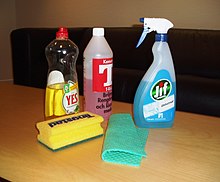Detergents are surfactant compounds that possess cleansing properties in dilute solutions. The term originates from the Latin word “detergere,” meaning to wipe or polish off.
Structure Creates Cleaning Power
Detergent molecules have a unique dual structure – a hydrophilic head that loves water and a hydrophobic tail that repels it. This structure lets detergents form micelles, tiny spheres that trap dirt and grease while staying dissolved in water. The molecules work best in alkaline conditions, with different types creating varying amounts of foam.
Four Major Classifications
Anionic Detergents Lead the Market
Alkylbenzene sulfonates dominate the market, with 6 billion kilograms produced annually. Their negative charge and molecular structure make them highly effective at removing dirt and grease.
Cationic Detergents Serve Special Purposes
These detergents use positively charged quaternary ammonium compounds but show limited cleaning power.
Non-ionic Detergents Offer Gentle Cleaning
Based on polyoxyethylene or glycoside structures, these uncharged detergents include popular brands like Tween and Triton.
Amphoteric Detergents Balance Charges
These specialized detergents contain equal positive and negative charges, like CHAPS, making them useful for specific applications.
Historical Evolution
The story of detergents begins in ancient Sumer around 2,500 BC with soap use. The first synthetic detergents emerged in Germany during WWI due to fat shortages. Henkel introduced the first commercial synthetic detergent in 1932, followed by Procter & Gamble’s Dreft in 1933.
Modern Applications
Household Cleaning Dominates
Modern detergents combine surfactants with builders, bleach, enzymes, and other additives for enhanced cleaning power. They come in various forms – powders, liquids, tablets, and pods.
Industrial Uses Expand
Detergents play crucial roles in:
- Fuel systems, preventing engine fouling at 300 ppm concentrations
- Biological research, helping isolate membrane proteins
- Industrial cleaning processes
The industry continues to develop more environmentally friendly formulations, replacing harmful phosphates with biodegradable alternatives like linear alkylbenzene sulfonate.
Citations:
https://en.wikipedia.org/wiki/Detergent
A detergent is a surfactant or a mixture of surfactants with cleansing properties when in dilute solutions. There are a large variety of detergents, a common family being the alkylbenzene sulfonates, which are soap-like compounds that are more soluble in hard water, because the polar sulfonate (of detergents) is less likely than the polar carboxylate (of soap) to bind to calcium and other ions found in hard water.

English
Etymology
From French détergent, from Latin dētergēns, the present participle of dētergeō
...
